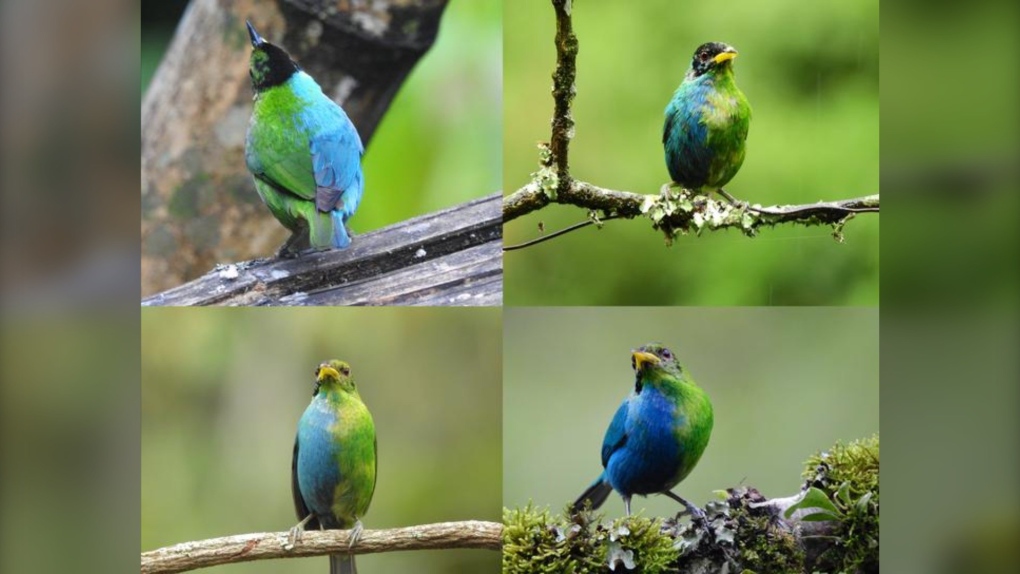When the bird first appeared in front of birdwatchers in Colombia, it was clear from its unique plumage — bright green on the left half of its body and blue on the right half, split neatly down the middle as though two birds had been glued together — that it was something special.
But what amateur ornithologist John Murillo didn't know as he snapped a photo of this rare, half-female, half-male bird was that this was the first time in more than 100 years that this the phenomenon had been recorded among this species of bird.
It's a rare condition called bilateral gynandromorphy, in which one side of an organism shows male characteristics and the other shows female.
"Many birdwatchers could go their whole lives and not see a bilateral gynandromorph in any species of bird. The phenomenon is extremely rare in birds, I know of no examples from New Zealand ever," Hamish Spencer, a professor at the University of Otago in New Zealand, said in a press release.
Spencer is the co-author of a paper describing the remarkable observation, published this month in the Journal of Field Ornithology.
He was on vacation in Colombia when Murillo pointed out a wild green honeycreeper that he had been observing, one with plumage that matched both male and female birds.
"It is very striking, I was very privileged to see it," Spencer said.
This is only the second time that bilateral gynandromorphy has ever been observed in a green honeycreeper, a small bird that is commonly seen across a swathe of territory stretching from southern Mexico to southeastern Brazil.
It's also the first time that a living green honeycreeper with bilateral gynandromorphy has been found.
"The phenomenon arises from an error during female cell division to produce an egg, followed by double-fertilization by two sperm," Spencer explained.
Cases of this unique condition have been recorded across numerous animal groups, but it's most easily spotted among animals with strong sexual dimorphism distinguishing males from females, such as birds.
And the visual difference between a male and female green honeycreeper couldn't be more stark.
Only the female birds are a true green with bright, grass-coloured plumage and a black-tipped, dull yellow beak. The male birds are aqua blue, though the study noted this is sometimes called "viridian green," and also have a black head and chin with a bright yellow beak.
The bird that caught Murillo's eye at the Reserva Natural Demostrativa Don Miguel, a small farm near the city of Manizales in Colombia, was clearly unlike any other green honeycreeper.
The bird's body colouring was split neatly down the middle, with this boundary line muddled in only a few places by stray feathers. The black crown of its head was broken up by a spray of green feather on the left side — the female, all-green side.
The farm had a feeding station set up for bird watching, which offered local birds fresh fruit and sugar water. Between October 2021 and June 2023, Murillo observed the bird when it appeared at the feeding station among the flocks of orioles, thrushes and euphonias. It tended to stick around for periods of around four to six weeks at a time in the area, and then wouldn't be seen at all for eight weeks straight.
The bird acted largely the same as other green honeycreepers — it ate, it chirped and it flew about, not receiving any harassment from other birds of its species as it did so. However, Murillo observed that it usually hung back at the feeder, waiting for other honeycreepers to leave before it would land to access the food. Once it was eating, it was territorial, not wanting to approach while it was eating.
"In general, it avoided others of its species, and the others also avoided it; it seems unlikely, therefore, that this individual would have had any opportunity to reproduce," the paper describes.
The last time someone came across a green honeycreeper with both male and female plumage was in 1914. In that case, the left side of the bird was male, which isn't the case with this new bird.
"This particular example of bilateral gynandromorphy — male one side and female the other — shows that, as in several other species, either side of the bird can be male or female," Spencer said.
Some previous case studies of birds with bilateral gynandromorphy have found that the internal organs were split by sex as well, with some birds possessing an ovary on the left side of their body and a testis on the right, or vice versa. Although researchers didn't see any particular mating behaviour from their green honeycreeper, the study also cited several previous studies that tracked birds with bilateral gynandromorphy and observed them behaving closer to a male or a female bird in their mating habits.
These birds, as unusual in appearance as they may be, have been shown to do all the things other birds can do, including leading successful courtships and going on to have chicks, the study noted.
This particular bird was able to be observed over a longer time period than many other previous case studies, "showing that our bird was well able to survive day-to-day events," the study noted.
One of the most exciting aspects of Murillo's discovery are his photographs, which Spencer called, "arguably the best of a wild bilateral gynandromorphic bird of any species ever."
Spencer added in the release that he hopes people will be inspired by this news to be on the lookout for more examples of these unusual and exceptional cases.











































